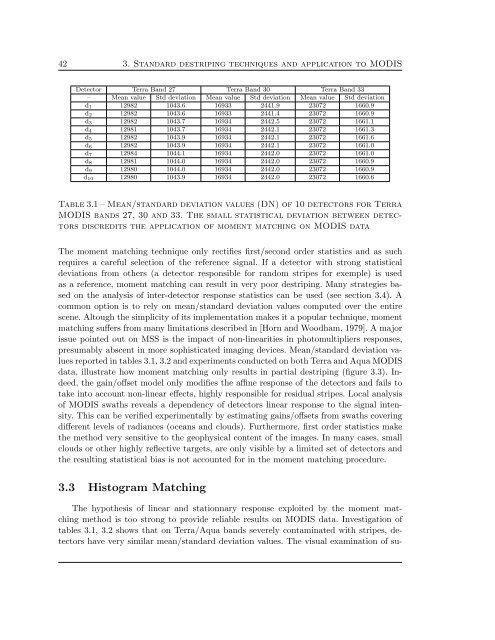Th`ese Marouan BOUALI - Sites personnels de TELECOM ParisTech
Th`ese Marouan BOUALI - Sites personnels de TELECOM ParisTech
Th`ese Marouan BOUALI - Sites personnels de TELECOM ParisTech
You also want an ePaper? Increase the reach of your titles
YUMPU automatically turns print PDFs into web optimized ePapers that Google loves.
42 3. Standard <strong>de</strong>striping techniques and application to MODIS<br />
Detector Terra Band 27 Terra Band 30 Terra Band 33<br />
– Mean value Std <strong>de</strong>viation Mean value Std <strong>de</strong>viation Mean value Std <strong>de</strong>viation<br />
d 1 12982 1043.6 16933 2441.9 23072 1660.9<br />
d 2 12982 1043.6 16933 2441.4 23072 1660.9<br />
d 3 12982 1043.7 16934 2442.5 23072 1661.1<br />
d 4 12981 1043.7 16934 2442.1 23072 1661.3<br />
d 5 12982 1043.9 16934 2442.1 23072 1661.6<br />
d 6 12982 1043.9 16934 2442.1 23072 1661.0<br />
d 7 12984 1044.1 16934 2442.0 23072 1661.0<br />
d 8 12981 1044.0 16934 2442.0 23072 1660.9<br />
d 9 12980 1044.0 16934 2442.0 23072 1660.9<br />
d 10 12980 1043.9 16934 2442.0 23072 1660.6<br />
Table 3.1 – Mean/standard <strong>de</strong>viation values (DN) of 10 <strong>de</strong>tectors for Terra<br />
MODIS bands 27, 30 and 33. The small statistical <strong>de</strong>viation between <strong>de</strong>tectors<br />
discredits the application of moment matching on MODIS data<br />
The moment matching technique only rectifies first/second or<strong>de</strong>r statistics and as such<br />
requires a careful selection of the reference signal. If a <strong>de</strong>tector with strong statistical<br />
<strong>de</strong>viations from others (a <strong>de</strong>tector responsible for random stripes for exemple) is used<br />
as a reference, moment matching can result in very poor <strong>de</strong>striping. Many strategies based<br />
on the analysis of inter-<strong>de</strong>tector response statistics can be used (see section 3.4). A<br />
common option is to rely on mean/standard <strong>de</strong>viation values computed over the entire<br />
scene. Altough the simplicity of its implementation makes it a popular technique, moment<br />
matching suffers from many limitations <strong>de</strong>scribed in [Horn and Woodham, 1979]. A major<br />
issue pointed out on MSS is the impact of non-linearities in photomultipliers responses,<br />
presumably abscent in more sophisticated imaging <strong>de</strong>vices. Mean/standard <strong>de</strong>viation values<br />
reported in tables 3.1, 3.2 and experiments conducted on both Terra and Aqua MODIS<br />
data, illustrate how moment matching only results in partial <strong>de</strong>striping (figure 3.3). In<strong>de</strong>ed,<br />
the gain/offset mo<strong>de</strong>l only modifies the affine response of the <strong>de</strong>tectors and fails to<br />
take into account non-linear effects, highly responsible for residual stripes. Local analysis<br />
of MODIS swaths reveals a <strong>de</strong>pen<strong>de</strong>ncy of <strong>de</strong>tectors linear response to the signal intensity.<br />
This can be verified experimentally by estimating gains/offsets from swaths covering<br />
different levels of radiances (oceans and clouds). Furthermore, first or<strong>de</strong>r statistics make<br />
the method very sensitive to the geophysical content of the images. In many cases, small<br />
clouds or other highly reflective targets, are only visible by a limited set of <strong>de</strong>tectors and<br />
the resulting statistical bias is not accounted for in the moment matching procedure.<br />
3.3 Histogram Matching<br />
The hypothesis of linear and stationnary response exploited by the moment matching<br />
method is too strong to provi<strong>de</strong> reliable results on MODIS data. Investigation of<br />
tables 3.1, 3.2 shows that on Terra/Aqua bands severely contaminated with stripes, <strong>de</strong>tectors<br />
have very similar mean/standard <strong>de</strong>viation values. The visual examination of su-















